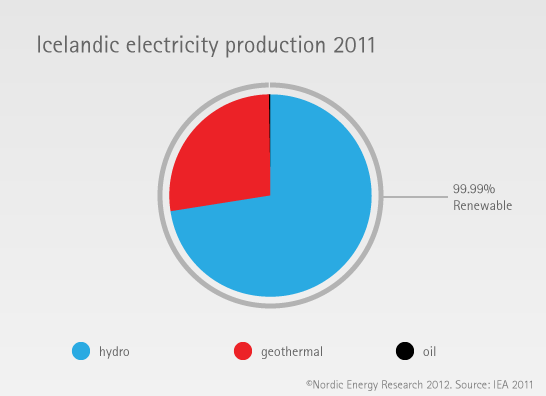
Introduction
Situated two-thirds of the way from the United States east coast and London, England, Iceland is one of the most geographically and culturally unique places on earth. Above ground, the island nation is covered in artic ice and glaciers, as well as beautiful meadows and valleys. Below ground, the scene is just as fascinating; lying on the junction of two tectonic plates, Iceland is a hub of geothermal activity as magma constantly churns under the surface. In this post, I want to explore how the unique geographic characteristics of the nation influence its infrastructure.

Energy Sources
One of the most sustainable countries in the world, almost all of Iceland’s electricity and energy comes from renewable sources, as shown in the graphic below. According to the Icelandic government, 73% of electricity production in 2015 was from hydropower, while 27% was from geothermal.

When looking at all energy consumption, renewable still dominates: 85% of the energy consumed comes from renewable sources, with 65% coming from geothermal and 20% coming from hydropower.

One of the most important factors in facilitating such a clean energy supply are the natural resources at Iceland’s disposal. As mentioned previously, the nation sits on a crucible of tectonic plate activity, providing almost endless amounts of energy in the form of heat. To give a simple explanation, the magma stored deep underground heats water reservoirs, making hot steam rise. This steam can either be used to spin a turbine and make electricity (figure on top), or it can be funneled into pipes and transported directly to towns for heating (figure on bottom).


Hydropower, the other major source of energy in the country, is also enabled by natural circumstances. Because 11% of Iceland is covered in glaciers, seasonal melts cause the formation of rapid rivers, providing ample amounts of kinetic energy that can be converted to electricity.

But the existing infrastructure didn’t spring up over night. For decades, Iceland relied on the same fossil fuels of oil, coal, and natural gas as the rest of the world. What, then, caused the shift? Although concern for the environment is certainly the main reason for the maintaining the infrastructure right now, it was the 1970’s oil crisis that really stimulated growth in renewable technology in Iceland. When oil-producing nations formed OPEC (Organization of the Petroleum Exporting Countries) to assert power over the world markets in the 1970s, economies all over the world were disrupted. Small nations like Iceland, which relied almost solely on imports of foreign sources of energy, were hit the hardest. Therefore, Iceland’s renewable infrastructure is based almost purely on economic value than moral merit.
